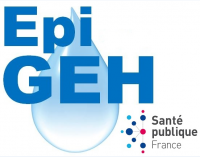In 2019, Santé publique France, in collaboration with the Directorate-General for Health and the Regional Health Authorities (RHA), initiated a national surveillance system for acute gastroenteritis (AGE) epidemics related to tap water consumption. These epidemics represent a real public health challenge at a local level with regard to the exposed population (between 20 and 50% of the population served by a contaminated water system is generally affected) and certain people in high-risk groups (immunocompromised, pregnant women). Although most epidemics occur in small to medium-sized municipalities, they can also affect large populations, as happened in the Grenoble area in 2016 and Grasse in 2019. In France, several epidemics of this nature are reported each year to Santé publique France, but their real impact is underestimated.
This project to set up a national surveillance system for GEA epidemics related to tap water consumption follows the recommendations of the World Health Organization (WHO) that in 2011 specified a conceptual framework for the implementation of Water Safety Plans (WSP). Its objectives are to improve knowledge about the health impact of waterborne epidemics, to provide epidemiological indicators related to tap-water consumption and to identify water networks at risk, as well as the circumstances of outbreaks, in order to guide preventive measures.
The article just published in the journal Eurosurveillance [1] presents the plan which has been deployed in each region of France, and the related public health issues.
3 questions for Jérôme Pouey and Damien Mouly, Regions Department (DiRe), Santé publique France


Waterborne epidemics of acute gastroenteritis (AGE) are most often linked to a contamination of the supply system of water intended for human consumption, or drinking water, by pathogens. Contamination usually occurs accidentally, either due to incidents in the distribution system (pipe break, return flows from treatment plants) or due to malfunctions or deficiencies during the treatment process of water production. In the latter case, resource vulnerabilities are a risk factor for the introduction of pathogens (farms near catchment areas, heavy precipitation, etc.).
Sanitary controls of drinking water allow for water supplies to be monitored in order to verify that the distributed water meets regulatory quality standards* according to a pre-defined sampling programme. The sampling carried out in this framework is done on an ad-hoc basis at a frequency mainly depending on the size of the population served or specific circumstances, such as following user complaints or accidental pollution, to decide when the quality standards are again respected. As a result, this method is not sensitive to the detection of one-off pollution events affecting small to medium-sized water networks that are analysed just a few times per year.
Unlike the sanitary checks performed on drinking water, which guarantee the quality of a water source according to a frequency of analysis based on the size of the population served, the surveillance system put into place directly monitors the health status of consumers by identifying grouped cases (or clusters) of AGE, in a systematic way on daily basis, for all water networks in France. This is independent of the size of the water network. In fact, it constitutes a sensitive health surveillance system for the whole population. It thus enables the detection of health signals at the level of water networks, regardless of whether there have been microbiological non-conformances identified by the sanitary controls. In this sense, it complements the sanitary control of water and contributes to reinforcing the consumer’s safety in relation to the risk of infection from tap water.
Its main limitation is the time taken to obtain and consolidate the health data (about 2 to 3 months) that comes from the Assurance Maladie [national health insurance], which means it cannot be used as a device for early alert or to limit the number of victims for a past event. By contrast, the identification of water networks for which clusters of AGE have been detected allows for a retrospective search into the circumstances of water contamination and for appropriate management measures to be carried out to avoid repeat situations.
The public-health benefit of this scheme is its ability to better estimate the health impact associated with tap water and to guide preventive actions against the infectious risk of tap water. The system can also be useful for assessing the effectiveness of actions implemented to secure a water system. In this way, it will be a useful complement to the sanitary control of drinking water now that the European Directive will impose on each Member State the establishment of water safety management plans (WSP).
The monitoring system is based on an ecological approach that combines an initial phase of statistical detection and signal selection (i.e., clusters of AGE) for which a waterborne source is plausible and, in a second stage, a phase of environmental investigations into the selected signals to confirm the waterborne origin and to identify the circumstances of the water system pollution.
In the first phase, a method for retrospective spatio-temporal detection of medical AGE (mAGE) clusters at the drinking water supply unit (UDI) level is applied using, respectively, data from the National Health Data System (SNDS) maintained by the Assurance Maladie (mAGE indicator per day and per commune) and data from the SISE-Eaux database (broken down by UDI/commune) maintained by the Directorate General for Health. This detection phase is carried out on all communes of France in an automated manner. Among the clusters identified using this method, epidemiological criteria based on past epidemics (cluster duration, number of observed and expected cases) are then used to select those with the highest waterborne plausibility. For each selected cluster, environmental investigations can then be initiated for the corresponding water production/distribution system.
For this second phase, the environmental investigations are based on information collected by the RHAs, including from the operators where necessary, on possible fragilities in the production, treatment and distribution of drinking water: collection point vulnerabilities, past cases of non-conformances with sanitary controls, known malfunctions (such as chlorination defects, wastewater return flows), complaints from users, external events such as rainfall that could have destabilized the pipeline, and any other events that may be considered as a point of entry for pathogens (network maintenance work, etc.). On the basis of the data gathered during these investigations and the associations known in the literature, the clusters are classified into 4 levels of waterborne plausibility: "strong", "probable", "possible" and "unknown".
Thus, over the period 2010 to 2019, 3,323 clusters showing epidemiological characteristics compatible with the hypothesis of a waterborne outbreak of AGE were detected. The latter corresponded to about 54,000 cases of excess medical AGE domiciled in 3,717 different distribution units (i.e., 15.4% of accounted units in the national territory in 2019). As the scheme only started in 2019, few environmental surveys on these detected clusters have been reported to date.
At this stage, although the sensitivity of the scheme is considered good (75% of the epidemics reported by RHAs to Santé publique France between 2010 and 2019 are identified as clusters in the detection phase), it remains difficult to assess the predictive value of the system. This quality may be estimated with the multiplication of environmental surveys connected to the RHA implementation of the 2019 circular**, which sets a target to investigate 1 statistical cluster by department and per year.
The scheme is based on multi-source data collection from various partners, including the Assurance Maladie, the Directorate General for Health, Météo-France, the RHAs, and water producers/distributors. Santé publique France develops and pilots the surveillance system, the collection of data, the list of statistical clusters and the selection of clusters for which a waterborne origin has been classified as plausible. The clusters thus retained are then prioritized and forwarded to the RHAs who can implement environmental investigations. These investigations are most often carried out by the health and environment services of local delegations within the RHAs. They are fundamental to the scheme because they allow the waterborne origin of the detected clusters to be objectified or disproved, and can identify the circumstances of the contamination.
Beyond the more recent clusters transmitted for environmental investigations, the historical data for detected clusters (available since 2010) also provide the RHAs with a list of water networks for which several clusters have been detected and which can therefore be considered as at most risk of microbiological contamination.
Information sharing is a key element in the development of this scheme. A shared tool for publishing the indicators and for monitoring the investigations was developed by Santé publique France: EpiGEH (see box). This tool was tested and refined in-house at Santé publique France during the surveillance system’s first phase of deployment, from 2019 to 2021.
EpiGEH will be available online for the various institutional partners, in particular the RHAs, via the state’s interministerial network from the end of 2021. Information sharing will also be ensured through epidemiological syntheses (national public health reports and their regional versions) to be published in 2022, which will provide a first review of the 3 years of surveillance.
For the first time in France, a monitoring scheme now enables routine assessment of the health impact of infectious risks borne by tap water at national, departmental and communal levels (including for small municipalities serving between 200 and 500 inhabitants), thus contributing to improving the quality of water for the consumer.
Box – The EpiGEH application: objectives
- Provide retrospective information on the nature and waterborne plausibility of signals detected by the surveillance system;
- allow members of regional coordination teams to update the classification of signals in the context of health and environmental investigations into those signals;
- provide Santé publique France teams and partners (national and regional) with information constructed from the mAGE health indicator that can be used to validate the health impact of environmental signals (e.g., a non-conformity reported by the RHA without the notion of mAGE signals at the time of the breach, pipeline rupture, heavy rain, etc.);
- to produce a national synthesis of indicators.

References:
[1] Pouey J, Galey C, Chesneau J, Jones G, Franques N, Beaudeau P; EpiGEH regional referents group, Mouly D. Implementation of a national waterborne disease outbreak surveillance system: overview and preliminary results, France, 2010 to 2019. Euro Surveill. 2021 Aug;26(34):2001466. doi: 10.2807/1560-7917.ES.2021.26.34.2001466. PMID: 34448447; PMCID: PMC8393890.
*Decree of 11 January, 2007 relating to the quality standards and references for untreated water and water intended for human consumption mentioned in sections R. 1321-2, R. 1321-3, R. 1321-7 and R. 1321-38 of the Public Health Code
** Ministry of Health, Instruction no. DGs/EA4/2019/46 of 27 February 2019 on the monitoring system for grouped cases of medicalised acute gastroenteritis in relation to a plausible waterborne origin. 2019, Ministry of Health: Paris, p. 12.